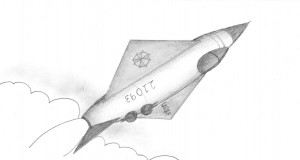 |
Set Course A-7609 for Mars, ¾ Speed Ahead. Pencil on paper, 2012. 6” x 10.5” A rendering of the spaceship Typhoon I from the images created for Trip to Mars, The Picture Book. |
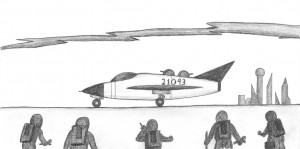 |
You Are Cleared for Pad 91. Pencil on paper, 2013. 6″ x 11″ The Typhoon I reveals its landing gear arrangement upon landing at Marsport in Trip to Mars, The Picture Book. |
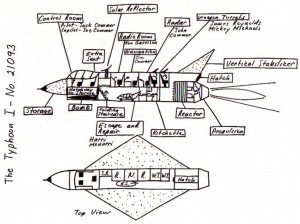 |
The Typhoon I. Pencil on paper, 1986. 8.5″ x 11” Traced from the October 1965 Martian Marauders manuscript drawing, with improved labels but no changes to the ship’s design except a slight change of position for the escape craft. |
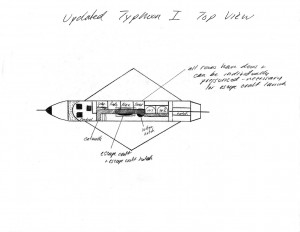 |
Updated Typhoon I Top View. Pencil on paper, 2003. 8.5” x 11” About the time I began a serious revision to The Martian Marauders I realized that the top turrets need to be centered in the ship and thus the catwalk has to veer to the center. Crew compartments are on the starboard side of the ship, but there also obviously needs to be something like upper storage compartments arranged on the port side for balance. I haven’t mentioned those in the series but though they’re not in this drawing they obviously need to exist. |
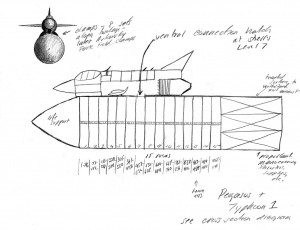 |
Typhoon I and Pegasus. Pencil on paper, 2004. 8.5” x 11” While writing Nonprofit Chronowar, in which copilot Joe Commer has serious post-traumatic stress disorder about his role in the destruction of the Earth in 2033 and the subsequent evacuation of the planet, I had to come up with at least a semi-plausible design for a passenger shell that could hold a thousand people. |
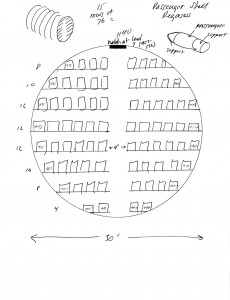 |
Passenger Shell Pegasus. Ink on paper, 2004. 11” x 8.5” Another working blueprint, a cross-section of the main passenger shell depicted in Nonprofit Chronowar. It could hold 1,140 people. |
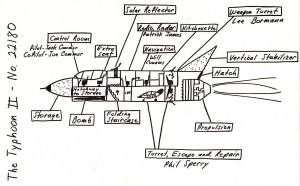 |
The Typhoon II. Pencil on paper, 1986. 8.5″ x 11” Traced from the October 1965 Martian Marauders manuscript drawing, with improved labels but no changes to the ship’s design. However, there are subtle improvements made in the design of the Typhoon II over the Typhoon I–just like in real life! Not bad for an eighth grader. |
 |
Typhoon II and Pod. Pencil and ink on paper, 2014. 8.5” x 11” From Jack Commer, Supreme Commander: He didn’t like the idea of a Pod attached to his sleek ship in the first place. It was like carting around a fashionable Marsport condominium, with its huge central recreation room, sixteen personal compartments for use by the three Martians and seven humans on the flight, as well as negotiation rooms where, everyone hoped, treaties would be hammered out with the Alpha Centaurians. The saucer had a kitchen, food to last several months, showers, exercise machines–and sixty-four Xon bombs in the lower compartment. These, added to the normal complement of four Xon bombs in the Typhoon II’s nose, along with the powerful pair of PlanetBlasters mounted on the back and belly of the craft, gave Jack the capability of destroying several solar systems in the course of an eight-hour work day–if negotiations failed. |
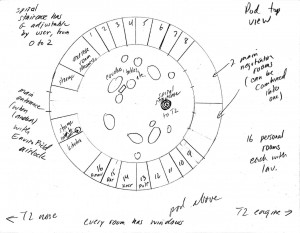 |
Pod Top View. Pencil on paper, 2004. 8.5” x 11” The Pod was hastily engineered between summer 2034 and the beginning of the Typhoon II mission to Alpha Centauri in February 2035. It had to be entered through an off-center top hatch and connecting tube which mated to the Typhoon II’s existing ventral hatch, with an adjustable-gravity spiral staircase into the Pod. The Pod’s main entrance on its saucer surface was never designed to be a true airlock for space, but it had an EnviroField airlock suitable for quick access to other spaceships or emergency use. |
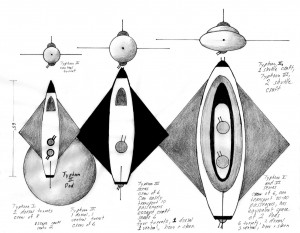 |
Typhoons I through VII – Top and Front Views. Pencil and ink on paper, 2014. 8.5” x 11” Relative sizes of Typhoon spacecraft in Jack Commer Books 1-6. Length of each set of craft, from nose to engine bell: Typhoons I and II, 65′; Typhoon III series, 77′; Typhoons V, VI, and VII: 105′ |
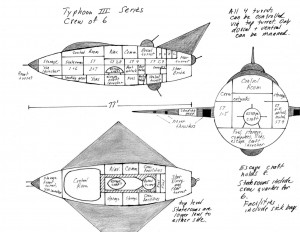 |
Typhoon III Series. Pencil and ink on paper, 2014. 8.5” x 11” Typhoons III and IV were the first of this series, with design work beginning 2038. Thirty-five Typhoon III-class ships were built through 2075. |
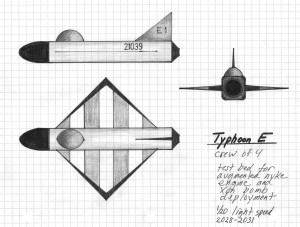 |
Typhoon E. Pencil and ink on graph paper, 2014. 8.5” x 11” Experimental vehicle 2028-2031 for the first augmented nuclear drive engine and Xon bomb delivery. 1/20 light speed, crew of 4. Created during the buildup to war with the Central Asian Powers. |
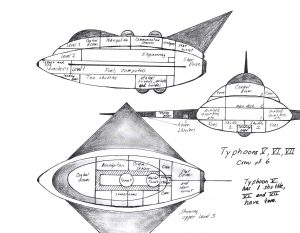 |
Typhoons V, VI, VII. Pencil and ink on paper, 2014. 8.5” x 11” To build the Typhoon V in 2075 cost roughly one-sixteenth of the Sol economy. However, with the assistance of the Ywritt of Iota Persei and the Four who traveled to Garr/thahg and walked for billions of years throughout all possible knowledge, the 2076 models, Typhoon VI and Typhoon VII, though the same size as the V, were vastly improved and capable of being built faster, better, and cheaper. |
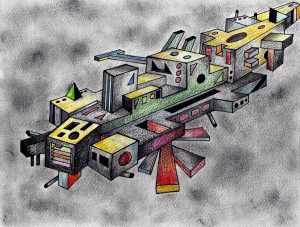 |
Clopt’s Infinite Spaceship. Pencil, colored pencil and charcoal on paper, 2017.
N8J’rallifh-hhu42jdnh, Clopt’s one hundred-mile-long flagship, ca. 15 miles by 15 miles by 100 miles, or 22,500 cubic miles. |
All words and images copyright by Michael D. Smith
